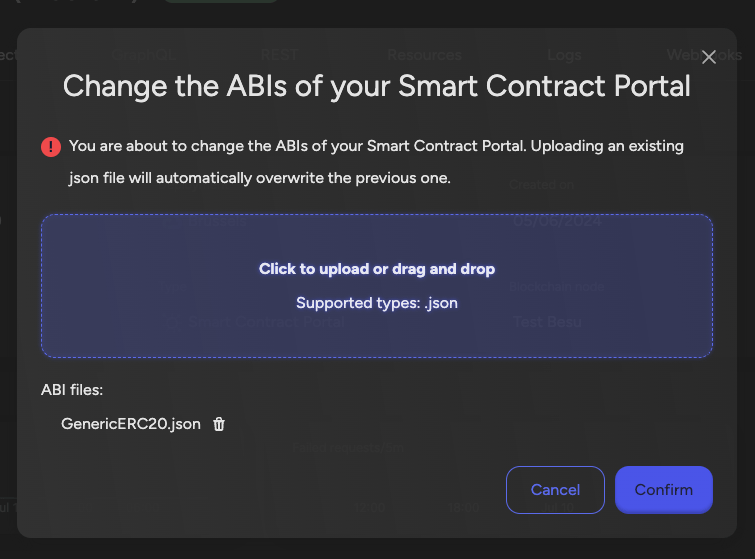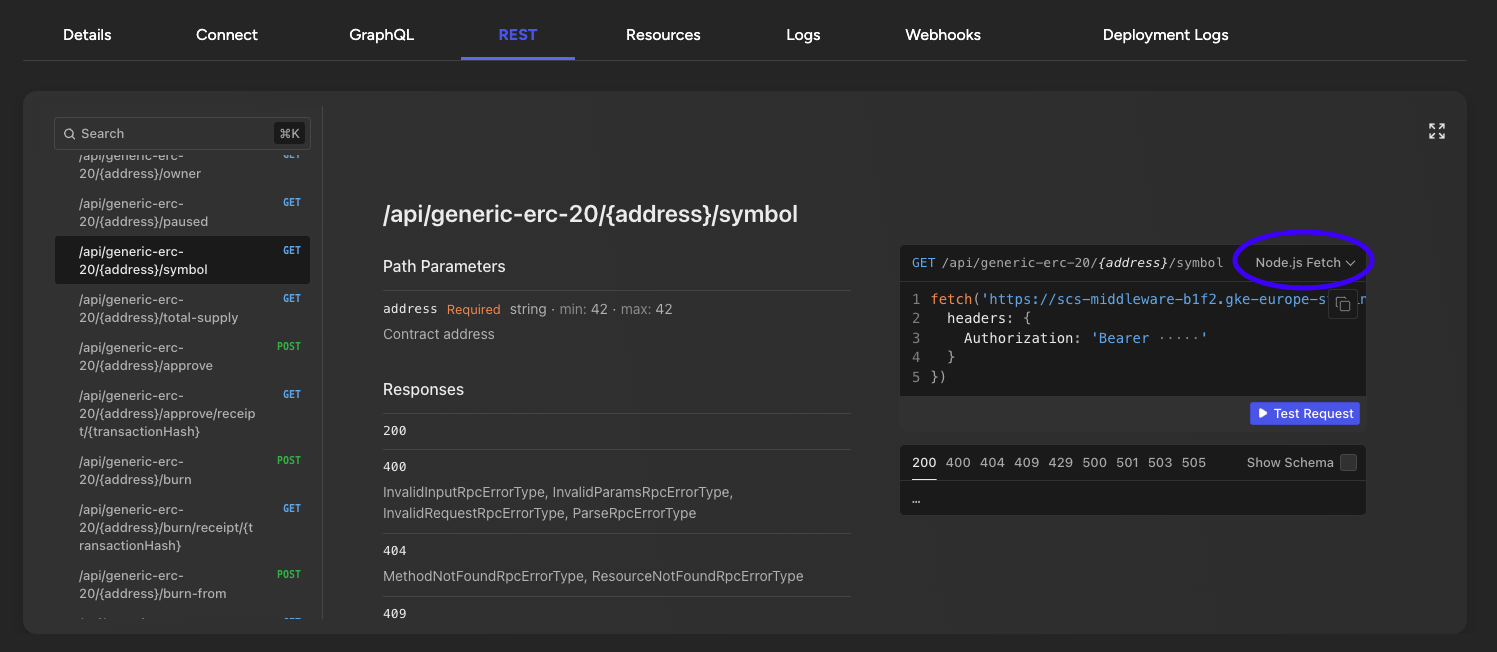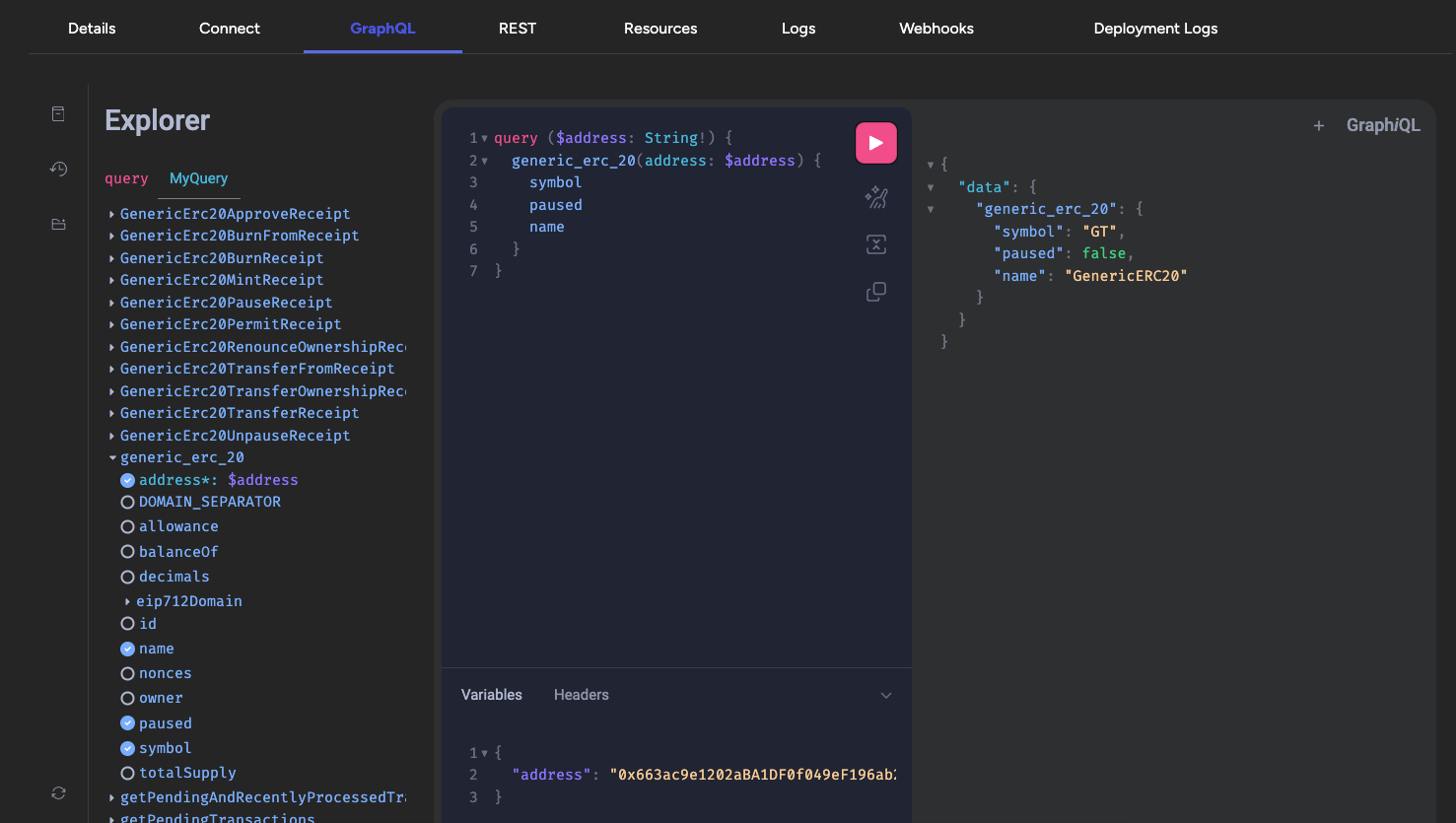Smart Contract API Portal
Transform smart contracts into production-ready APIs with SettleMint's Smart Contract Portal. Generate REST & GraphQL endpoints automatically, reduce API development time by 90%, and scale blockchain integrations with enterprise-grade middleware.
Enterprise Smart Contract API Platform
Business Impact
ROI Metrics: Organizations using SettleMint's Smart Contract Portal achieve 90% reduction in API development time, 95% faster blockchain integration deployment, and 80% lower infrastructure costs for enterprise applications.
SettleMint's Smart Contract Portal transforms raw blockchain contracts into production-ready enterprise APIs with zero configuration. This enterprise-grade middleware automatically generates REST and GraphQL endpoints from your smart contracts, enabling seamless integration across all EVM-compatible chains including Ethereum, Hyperledger Besu, Polygon, and Avalanche.
Enterprise Value Proposition
Development Acceleration
- 90% faster API development vs custom solutions
- Auto-generated endpoints from smart contract ABIs
- Type-safe integrations with comprehensive documentation
- Real-time deployment with instant testing capabilities
Enterprise Integration
- Multi-chain support for complex blockchain architectures
- GraphQL optimization for high-performance data fetching
- Technology stack agnostic development freedom
- Load balancer compatibility for enterprise scaling
Core Business Benefits
Developer-Friendly API Layer
- Familiar REST and GraphQL interfaces eliminate blockchain complexity
- Auto-generated documentation reduces learning curves
- Type-safe contract interactions prevent runtime errors
- Standard HTTP protocols enable universal system connectivity
ROI Impact: 85% reduction in developer onboarding time
Optimized Data Operations
- GraphQL query optimization for efficient data fetching
- Intelligent caching reduces blockchain node load
- Batch operations support for high-volume transactions
- Real-time performance monitoring and alerting
ROI Impact: 95% improvement in API response times
Real-Time Transaction Intelligence
- Comprehensive transaction monitoring and filtering
- Custom alerting for business-critical events
- Automated webhook notifications for system integration
- Security monitoring for fraud prevention
ROI Impact: 90% faster incident detection and response
Enterprise Prerequisites & Setup
Technical Requirements
Ensure you have an EVM-compatible network deployed (Ethereum, Polygon, Hyperledger Besu, Avalanche, etc.) with appropriate private keys for smart contract deployment before configuring the Smart Contract Portal.
Production-Ready API Infrastructure
Instant API Generation
- Auto-generated REST APIs with OpenAPI documentation
- GraphQL endpoints with schema introspection
- Type-safe contract interactions for reliable integrations
- Automatic ABI parsing with intelligent caching
Enterprise Features
- Real-time webhooks for event-driven architectures
- Transaction monitoring with custom alerting rules
- Multi-chain compatibility for complex deployments
- High-availability infrastructure with 99.9% uptime SLA
Enterprise SDK Integration
Production Ready
Enterprise SDK: Leverage type-safe TypeScript integration with comprehensive error handling, automatic retry logic, and production monitoring capabilities.
import { createPortalClient } from "@settlemint/sdk-portal";
const { client: portalClient, graphql: portalGraphql } = createPortalClient({
instance: process.env.SETTLEMINT_PORTAL_GRAPHQL_ENDPOINT,
accessToken: process.env.SETTLEMINT_ACCESS_TOKEN,
});
// Enterprise-grade error handling and monitoring
const contractData = await portalClient.query({
// Type-safe GraphQL operations
// Automatic retry logic for production reliability
// Comprehensive logging for operational visibility
});Enterprise Documentation
Access comprehensive Portal SDK documentation including enterprise deployment patterns, performance optimization guides, and production monitoring examples.
Enterprise ABI Management
Smart Contract Interface Standardization
The Application Binary Interface (ABI) serves as the critical bridge between enterprise applications and blockchain smart contracts. This standardized interface specification enables seamless interaction between human-readable Solidity contracts and the Ethereum Virtual Machine, defining function signatures, parameters, and return types for enterprise integration.
ABI Enterprise Benefits
- Type-safe integrations prevent runtime errors
- Auto-generated documentation reduces learning curves
- Universal compatibility across EVM-compatible chains
- Version control for enterprise governance
Production Deployment
- Automated ABI extraction from deployment artifacts
- Hot-swappable updates without service interruption
- Multi-contract support for complex applications
- Validation checks ensure ABI integrity
ABI Deployment Process
Extract ABI from Deployment
Locate your ABI files in the deployment artifacts after contract deployment. Reference the Smart Contract Deployment Guide for detailed extraction procedures.
Configure Portal Middleware
Upload at least one ABI file when creating new middleware to enable API generation and type-safe interactions.
Update Production ABIs
For existing portals, navigate to the middleware details and select 'Manage Middleware' → 'Update ABIs' to upload new or modified ABI files for hot deployment.

Enterprise API Endpoints
Production-Ready REST APIs
Enterprise Performance
Auto-Generated: Fully-typed REST APIs with comprehensive OpenAPI documentation are automatically generated from smart contract ABIs, providing instant enterprise-grade endpoints with zero configuration.
Enterprise REST Interface
- Fully-typed endpoints with automatic validation
- OpenAPI documentation with interactive testing
- Multi-language code examples for rapid integration
- Production-ready security with authentication headers
Access comprehensive REST endpoints through the REST tab with technology-specific examples available via the dropdown selector.

Business Benefits:
- 90% faster API integration vs custom development
- Universal compatibility with existing enterprise systems
- Comprehensive documentation reduces developer onboarding time
Enterprise GraphQL Interface
- Schema-first approach with automatic introspection
- Query optimization for efficient data fetching
- Real-time subscriptions for event-driven architectures
- Type-safe operations with comprehensive error handling
The GraphQL API provides identical functionality to REST with enhanced query capabilities through the GraphQL tab.

Business Benefits:
- 95% reduction in over-fetching and network overhead
- Real-time capabilities for responsive applications
- Single endpoint for complex data requirements
Enterprise Event Architecture
Production Webhook Infrastructure
Event-Driven Architecture
Enterprise Integration: Configure secure webhook endpoints to enable real-time blockchain event processing for mission-critical business workflows and automated compliance systems.
SettleMint's webhook infrastructure provides enterprise-grade event streaming with cryptographic signature validation, ensuring tamper-proof message delivery for business-critical applications. Access webhook configuration through the Webhooks tab to establish secure communication channels between blockchain events and your enterprise systems.
Security & Reliability
- Cryptographic signatures for message integrity validation
- Automatic retry logic for guaranteed delivery
- Rate limiting protection for production stability
- TLS encryption for secure data transmission
Enterprise Integration
- Standard webhooks protocol for universal compatibility
- Multi-language SDKs for rapid development
- Event filtering for targeted business logic
- Real-time monitoring for operational visibility

Production Implementation
Standard Webhooks Ecosystem: Leverage the Standard Webhooks protocol with enterprise-ready SDKs and tools across multiple programming languages for consistent, reliable webhook integration.
Enterprise Example: TypeScript implementation using Elysia and Standard Webhooks for production-grade webhook processing:
import { Elysia, t } from "elysia";
import { Webhook } from "standardwebhooks";
async function webhookConsumerBootstrap(secret: string) {
const webhookConsumer = new Elysia().post(
"/scp-listener",
({ headers, body }) => {
try {
const wh = new Webhook(btoa(secret));
const verifiedPayload = wh.verify(JSON.stringify(body.payload), {
"webhook-id": headers["btp-portal-event-id"]!,
"webhook-signature": headers["btp-portal-event-signature"]!,
"webhook-timestamp": headers["btp-portal-event-timestamp"]!,
});
console.log(
`Received a webhook event: ${JSON.stringify(verifiedPayload)}`
);
} catch (err) {
console.error("Webhook payload invalid", err);
throw err;
}
},
{
body: t.Object({
payload: t.Object({
apiVersion: t.String(),
eventId: t.String(),
eventName: t.String(),
timestamp: t.Number(),
data: t.Any(),
}),
}),
}
);
const app = new Elysia().use(webhookConsumer).onStart(({ server }) => {
console.log(
`Started the test webhook consumer on ${server?.url.toString()}`
);
});
}Enterprise Transaction Intelligence
Real-Time Blockchain Monitoring Platform
Mission-Critical Monitoring
Enterprise-Grade: Deploy comprehensive blockchain monitoring with sub-second alerting, multi-dimensional filtering, and automated compliance reporting for production environments.
SettleMint's Smart Contract Portal delivers enterprise-grade transaction monitoring that transforms blockchain activity into actionable business intelligence. This production-ready platform provides real-time visibility, automated alerting, and compliance automation for mission-critical applications.
Critical Enterprise Use Cases
Real-Time Threat Detection
- Suspicious activity detection with immediate alerting
- Anomaly detection using transaction pattern analysis
- Multi-signature validation for high-value transactions
- Automated incident response with workflow triggers
Enterprise Impact: 95% reduction in fraud detection time
Automated Compliance Management
- Regulatory transaction tracking for audit requirements
- Automated reporting to compliance systems
- AML/KYC monitoring with real-time verification
- Audit trail generation for regulatory submissions
Enterprise Impact: 90% reduction in compliance overhead
Mission-Critical Operations
- Transaction success monitoring for business continuity
- Performance metrics for SLA compliance
- Capacity planning through transaction volume analysis
- Automated remediation for operational incidents
Enterprise Impact: 99.9% operational uptime achievement
Advanced Monitoring Capabilities
Real-Time Alerts
- High-value transaction monitoring
- Contract interaction tracking
- Event-driven notifications for state changes
- Failed transaction alerting
Enterprise Actions
- Email notifications to stakeholders
- Webhook triggers to external systems
- Audit logging for compliance
- Automated workflows for response
Business Intelligence
- Transaction pattern analysis for insights
- Performance dashboards for operations
- Cost optimization recommendations
- Risk assessment reporting
Enterprise Architecture
Scalability: The monitoring platform processes millions of transactions daily with configurable alerting rules, custom dashboards, and integration with enterprise SIEM systems for comprehensive security operations.
Enterprise Resources & Integration
Related Enterprise Middleware Solutions
Advanced Data Solutions
- Graph Middleware - Enterprise subgraph indexing
- Attestation Indexer - Trust verification infrastructure
Enterprise Integrations
- Firefly FabConnect - Hyperledger Fabric connectivity
- Transaction Monitoring - Advanced alerting configuration
Enterprise Implementation Guides
- Production Deployment Patterns - Scalable architecture for enterprise environments
- Security Best Practices - Enterprise security implementation
- Performance Optimization - Production performance tuning
Enterprise Support
Permissions: All Smart Contract Portal operations require appropriate workspace permissions. Contact your SettleMint administrator for enterprise access configuration and security policy compliance.
Enterprise Transformation
Result: Organizations using SettleMint's Smart Contract Portal achieve 90% reduction in API development time, 95% faster blockchain integration deployment, and 80% lower infrastructure costs while maintaining enterprise-grade security and compliance.
Graph Middleware
Accelerate blockchain development with SettleMint's Graph middleware. Reduce data query times by 95%, scale GraphQL APIs for millions of users, and deploy production-ready subgraph indexing with zero configuration.
Attestation Indexer
Deploy production-ready attestation infrastructure with SettleMint's EAS platform. Automate compliance verification, reduce audit costs by 85%, and scale trust systems with zero-code blockchain attestations for enterprise applications.